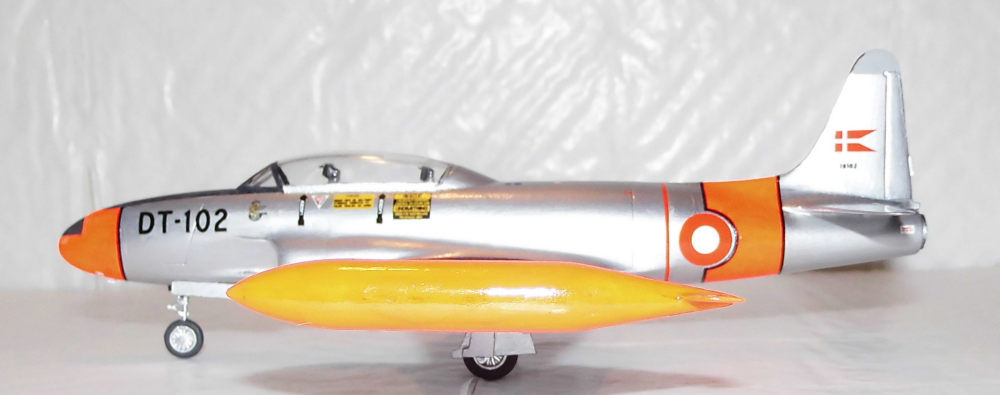
Hasegawa 1/72 Lockheed T-33A Shooting Star
| KIT #: | A018 |
| PRICE: | 25DKK a lot time ago |
| DECALS: | one option |
| REVIEWER: | Nicolai Plesberg |
| NOTES: | Stoppel 72-140 decals |

| HISTORY |
This is one of the true classic jet trainers as it’s basically the two-seat version of the Lockheed F-80 Shooting Star, America’s first successful jet fighter. More than 6700 were built including licence manufacturing in Japan (210) and Canada (656) and outstripped production of the single-seat F-80 by almost 4 to 1. More than 30 nations worldwide became users of this magnificent jet trainer and Bolivia, as the last sole operator left, have just recently retired their last T-33s.
The Royal Danish Air Force received in 1951-54 12 MDAP T-33s and these were supplied with 14 surplus planes bought from the USAF in 1961. In the beginning the planes flew with the code letters “TR-“ followed by the three last digits of the USAF serial, but in 1960 the numbers were changed to “DT-“ and still with the last three digits from their USAF serial. Dayglo bands on fuselage and wings were added to make them more visible in bad weather.
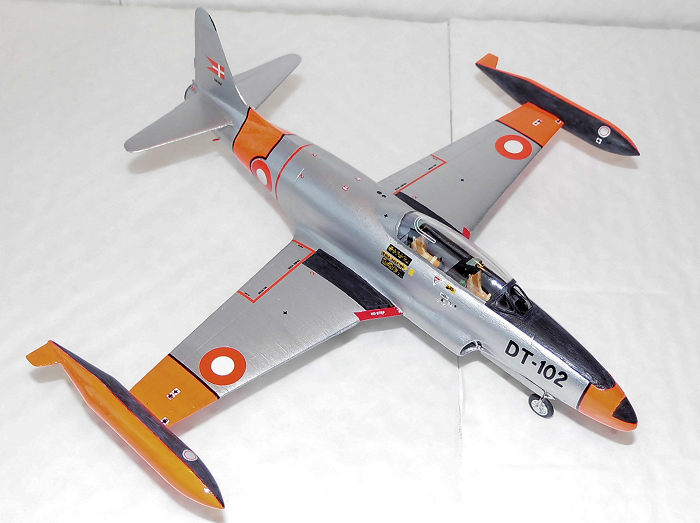 All planes
had their original Lockheed ejection seats replaced with Martin-Baker Mk
DU5A-1/2 (A-1 front seat / A-2 rear seat) in the early / mid 60s. The T-33 was
used first and foremost to get the pilots, who had been trained in the US and
Canada, used to Danish conditions, such as climate and the terrain. Furthermore
a lot of navigational as well as formation practice was implemented in their
training before being sent to the combat squadrons for combat training.
All planes
had their original Lockheed ejection seats replaced with Martin-Baker Mk
DU5A-1/2 (A-1 front seat / A-2 rear seat) in the early / mid 60s. The T-33 was
used first and foremost to get the pilots, who had been trained in the US and
Canada, used to Danish conditions, such as climate and the terrain. Furthermore
a lot of navigational as well as formation practice was implemented in their
training before being sent to the combat squadrons for combat training.
The T-33 was also used in other roles, such as target tugs, liaison, ECM flights and target practice for the GCI control stations. In the 26 years the T-33 served with the RDAF only 8 were lost in crashes, including three planes that were destroyed in a hangar fire.
In all more than 100,000 flight hours were logged in service which lasted until May 17 1977 when the last flight was performed.
| THE KIT |
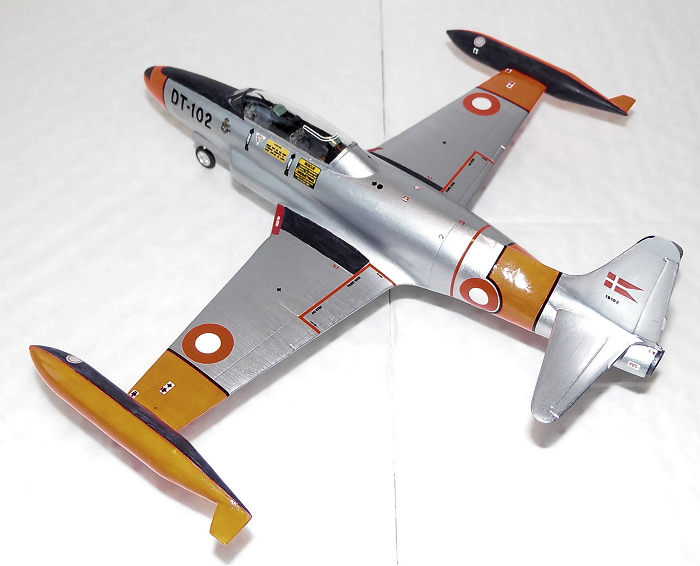 The
Hasegawa kit has been around for quite a while, since it sports raised panel
lines as well as a mediocre interior / gear / gear- and airbrake bays, but of
course well below current standards. Fit is okay but filler is needed in slight
amounts here and there. Markings in this boxing are for two JASDF versions, but
I was going to make this a Danish build as well. The only markings from the kit
sheet I used were the two instrument panels, which look quite good and fit the
respective plastic parts pretty well (this is not always the case!).
The
Hasegawa kit has been around for quite a while, since it sports raised panel
lines as well as a mediocre interior / gear / gear- and airbrake bays, but of
course well below current standards. Fit is okay but filler is needed in slight
amounts here and there. Markings in this boxing are for two JASDF versions, but
I was going to make this a Danish build as well. The only markings from the kit
sheet I used were the two instrument panels, which look quite good and fit the
respective plastic parts pretty well (this is not always the case!).
| CONSTRUCTION |
Construction started by gluing the tip tanks and the wing parts together. The ejection seats were then modified to look like Martin-Baker seats by modifying the headrest plus adding a few other bits and bobs after dealing with the sink marks that the seats were festooned with. The instrument panel for the back-seater was attached to the floor then the interior bits were painted grey (Vallejo 991) and the seat frames went satin black (seems also to be a Martin-Baker trademark anyway). Some more detail painting of the seats was done next plus the addition of smaller details including the firing handles from thin copper wire. The rear instrument panel was glossed, the decal attached (with the carrier film edges removed to get an exact fit) and some more painting was done, but this time with the landing gear, doors and intakes, which went silver.
After
securing the panel decal with some flat varnish, some nose weight was measured
and glued into front of both fuselage halves, then gluing the interior together
with fuselage halves. When set the seam was dealt with the usual way; also the
wing tip tanks were dealt with in the same manner. I also attached a piece of
plastic sheet to form the bottom of the nose gear bay, as it is hollow right up
in the nose section. Some
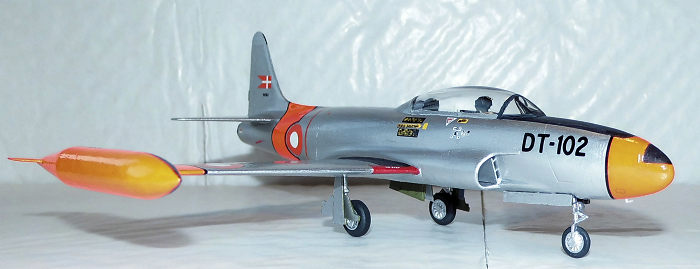 touch up of
the grey color was done then glossing the front instrument panel; it is split on
the floor and the fuselage halves and the decal can only be attached when they
have been glued together and painted. When dry it was sealed with flat varnish
and the cockpit finalized with painting the edges flat black.
touch up of
the grey color was done then glossing the front instrument panel; it is split on
the floor and the fuselage halves and the decal can only be attached when they
have been glued together and painted. When dry it was sealed with flat varnish
and the cockpit finalized with painting the edges flat black.
Now came a rather big assembly session as seats and sticks were glued into the cockpit and intakes, wings and tail planes glued to the fuselage. They were, when set, glue filled as there is really no reason to use filler here; it seems to be exaggerating to do so. The nose piece was also glued to the fuselage and some plastic shims glued to the exhaust to get a better fit for the exhaust tube piece, which was attached as things had set hard. When all those things had dried a couple of seam sanding / filling sessions followed to finish up the airframe. As soon as the airframe had been finished, some touch up of the black in the cockpit was necessary, but right after that the canopy was cleaned and attached with clear gloss varnish. Some gap filling with the gloss was necessary but accomplished without difficulty. Some careful sanding around the canopy edge came next; I use grit 1200 wet & dry for this, as it gives a satisfying result. To finish up the tip tanks, I thinned the tank fins and then glued the tanks to the wing tips. Some glue filling was also necessary to fill the small gaps that remained as were small imperfections around diverse seams still not properly dealt with, but they got there before returning to paint some more. This time the gear bays plus the inner side of gear doors which went interior green (Humbrol 226). The canopy frames went flat black plus tires went tire black and gear finished up. The model was then cleaned thoroughly, gear mounted and it was off to the paint shop.
| COLORS & MARKINGS |
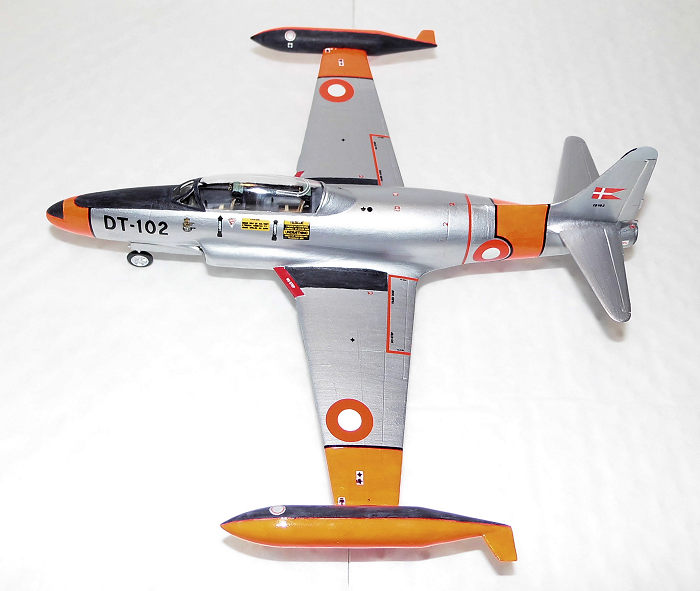 I began
painting by applying an undercoat of flat white on all surfaces, except, of
course, the canopy! When set the areas that would be dayglo orange were masked
off and applied. Five coats were necessary to get a perfect coverage. After the
last coat the masking tape was removed and some new applied to mask off the
walkways and anti-glare (later to be painted black) and the inner part of the
wing leading edges (later to be painted red). Silver was then applied to the
remaining airframe in several coats. After the last coat the tape was removed
and the model set to dry completely through.
I began
painting by applying an undercoat of flat white on all surfaces, except, of
course, the canopy! When set the areas that would be dayglo orange were masked
off and applied. Five coats were necessary to get a perfect coverage. After the
last coat the masking tape was removed and some new applied to mask off the
walkways and anti-glare (later to be painted black) and the inner part of the
wing leading edges (later to be painted red). Silver was then applied to the
remaining airframe in several coats. After the last coat the tape was removed
and the model set to dry completely through.
Several minor things were painted next; exhaust went burned metal, inner leading edges of the wings went red (in several coats), walkways and anti-glare panel went flat black, fin top grey and of course also spiced with the usual touch ups in between. Finally I could apply the gloss coat for the decals.
The decals went on with no special issues. I was happy that the black demarcation lines between the dayglo and the metal came as decal stripes – it would have been a bear to mask and paint those on! The squadron badge came from that special anniversary sheet I mentioned in my Thunderflash review.
The decals were secured with a coat of gloss when they’d set. The walkways plus anti-glare was given a flat coat to give a realistic appearance on those areas. The last items consisted of the absolute final touch ups plus adding the missing details, such as antennas, fuel dumps etc. including the painting of those items.
| CONCLUSIONS |
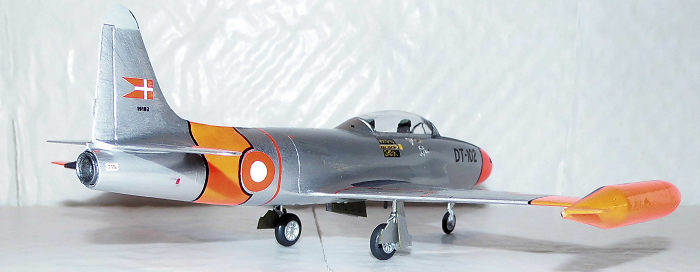 Well, there
it is – one of the golden oldie kits of one of the olden oldies, the Hasegawa
Lockheed T-33A in all its glory. It builds pretty easy and can be done by all
skill levels. I know there are several other 72nd
scale kits of the T-33 out there, some may be of newer date, but I find that the
Hasegawa kit still does the job admirably.
Well, there
it is – one of the golden oldie kits of one of the olden oldies, the Hasegawa
Lockheed T-33A in all its glory. It builds pretty easy and can be done by all
skill levels. I know there are several other 72nd
scale kits of the T-33 out there, some may be of newer date, but I find that the
Hasegawa kit still does the job admirably.
| REFERENCES |
Wikipedia, the Online Encyclopedia
Forsvarets fly efter 1945, FLV / tinbox 1987. This booklet does give some information of, among other types, the T-33 in Danish service. Unfortunately it is only published in Danish so the value to others may be rather limited – not to mention about acquiring it!
17 July 2018
Copyright ModelingMadness.com
If you would like your product reviewed fairly and fairly quickly, please contact the editor or see other details in the Note to Contributors.